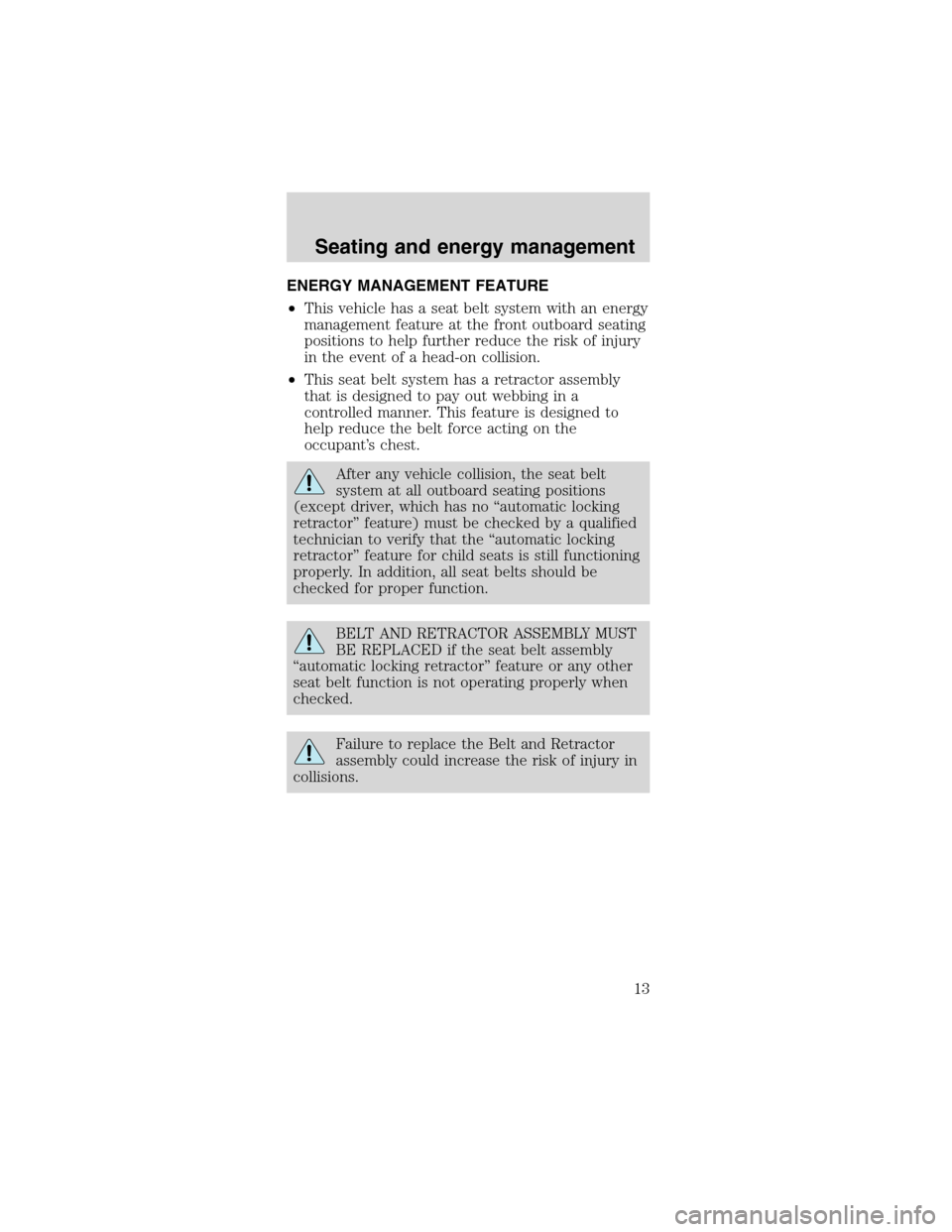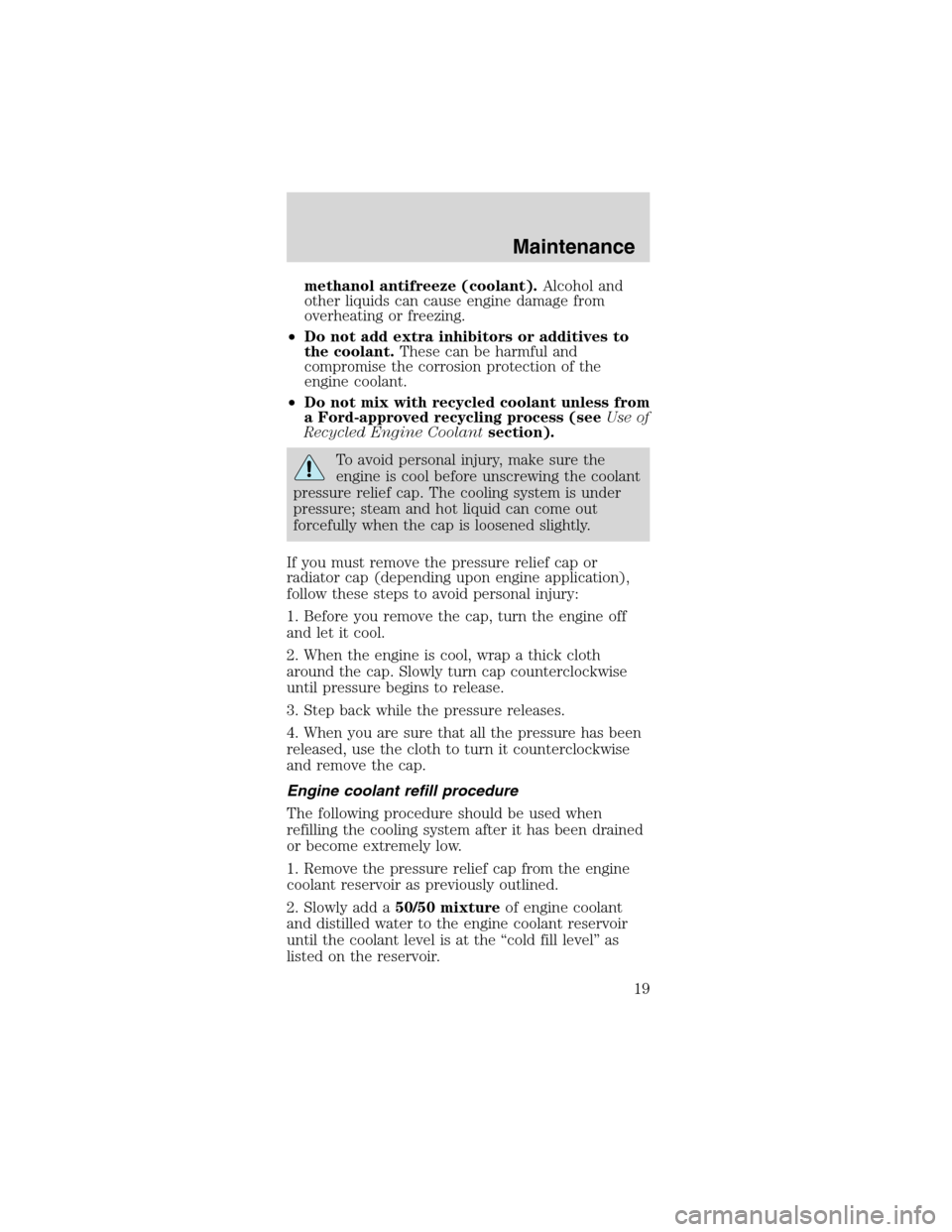Page 5 of 32
•4.6L DOHC 32V Supercharged V–8 Engine with
Intercooler—390 horsepower, 390 lb-ft torque
•T56 6 speed transmission
•Aluminum flywheel
•Engine oil cooler
•Power steering cooler
•Anti-lock Brake System with Traction Control�
•Limited-slip independent rear suspension
•SVT-tuned suspension and brakes
•17”x9”cast aluminum wheels
•275/40ZR17 BSW Performance Tires
•Specially tuned stainless steel exhaust system
•Decklid spoiler, hood, rocker moldings, front and
rear fascia
•Round fog lamps
•Color keyed fold away mirrors
•Unique cloth top (convertible only)
•Interval wipers with aerodynamic wiper/blade
•Electroluminescent cluster with boost gauge
•Sport seats with adjustable driver bolsters and
leather and preferred suede seating surfaces
•Sport pedals with aluminum covers
•Leather wrapped sport steering wheel
Cobra unique standard features
5
Page 7 of 32
4.6L DOHC SUPERCHARGED V–8 ENGINE
1. Engine oil filler cap
2. Brake fluid reservoir
3. Engine oil dipstick
4. Power distribution box
5. Windshield washer fluid reservoir
6. Battery
7. Power steering fluid reservoir
8. Engine coolant reservoir
9. Intercooler reservoir
10. Air filter assembly
11. Auxiliary power distribution block
12. Supercharger
Engine/Transmission
7
Page 8 of 32
Item Description
ConfigurationLongitudinally mounted,
90-degree V8, cast iron
cylinder block and cast
aluminum cylinder heads
Bore x Stroke90.2 x 90.0 mm (3.55 x 3.54
in)
Displacement4601 cc/280 cid
Compression ratio8.5:1
Horsepower239 kW @ 6000 rpm (390 HP
@ 6000 rpm)
Torque430 Nm @ 4800 rpm (390
lb.-ft. @ 4750 rpm)
Redline6500 rpm (fuel shut-off at
7000 rpm)
Specific output84.8 HP per liter
ValvetrainDual overhead chain-driven
cams, roller finger followers
with hydraulic lash
adjustment, ovate-wire valve
springs, four valves per
cylinder
Fuel systemSequential electronic fuel
injection
Mass air sensor90 mm (3.54 in) diameter
Throttle bodyTwin 57 mm (2.24 in)
diameter bore-simultaneously
open
Exhaust manifoldsCast-high silicon,
molybdenum iron
Exhaust systemDual-stainless steel
Engine/Transmission
8
Page 13 of 32

ENERGY MANAGEMENT FEATURE
•This vehicle has a seat belt system with an energy
management feature at the front outboard seating
positions to help further reduce the risk of injury
in the event of a head-on collision.
•This seat belt system has a retractor assembly
that is designed to pay out webbing in a
controlled manner. This feature is designed to
help reduce the belt force acting on the
occupant’s chest.
After any vehicle collision, the seat belt
system at all outboard seating positions
(except driver, which has no“automatic locking
retractor”feature) must be checked by a qualified
technician to verify that the“automatic locking
retractor”feature for child seats is still functioning
properly. In addition, all seat belts should be
checked for proper function.
BELT AND RETRACTOR ASSEMBLY MUST
BE REPLACED if the seat belt assembly
“automatic locking retractor”feature or any other
seat belt function is not operating properly when
checked.
Failure to replace the Belt and Retractor
assembly could increase the risk of injury in
collisions.
Seating and energy management
13
Page 19 of 32

methanol antifreeze (coolant).Alcohol and
other liquids can cause engine damage from
overheating or freezing.
•Do not add extra inhibitors or additives to
the coolant.These can be harmful and
compromise the corrosion protection of the
engine coolant.
•Do not mix with recycled coolant unless from
a Ford-approved recycling process (seeUse of
Recycled Engine Coolantsection).
To avoid personal injury, make sure the
engine is cool before unscrewing the coolant
pressure relief cap. The cooling system is under
pressure; steam and hot liquid can come out
forcefully when the cap is loosened slightly.
If you must remove the pressure relief cap or
radiator cap (depending upon engine application),
follow these steps to avoid personal injury:
1. Before you remove the cap, turn the engine off
and let it cool.
2. When the engine is cool, wrap a thick cloth
around the cap. Slowly turn cap counterclockwise
until pressure begins to release.
3. Step back while the pressure releases.
4. When you are sure that all the pressure has been
released, use the cloth to turn it counterclockwise
and remove the cap.
Engine coolant refill procedure
The following procedure should be used when
refilling the cooling system after it has been drained
or become extremely low.
1. Remove the pressure relief cap from the engine
coolant reservoir as previously outlined.
2. Slowly add a50/50 mixtureof engine coolant
and distilled water to the engine coolant reservoir
until the coolant level is at the“cold fill level”as
listed on the reservoir.
Maintenance
19
Page 23 of 32

WRECKER TOWING
If you need to have your vehicle towed, contact a
professional towing service or, if you are a member,
your roadside assistance center.
It is recommended that your vehicle be towed only
with flatbed equipment and that 4x4 blocks must be
used when loading/unloading your vehicle. Do not tow
with a wheel lift or a slingbelt. Ford Motor Company
has not approved a slingbelt towing procedure.
If the vehicle is towed by other means or
incorrectly, vehicle damage may occur.
Ford Motor Company produces a towing manual for
all authorized tow truck operators. Have your tow
truck operator refer to this manual for proper
hook-up and towing procedures for your vehicle.
Auxiliary power distribution block
Cobra vehicles have an auxiliary power distribution
block that is located by the air cleaner assembly.
Fuse Amp RatingPower Distribution Box Description
30A CB High-speed fan
Full ISO Relay Intercooler Pump
Please refer to your owner’s guide for complete
fusing information.
Roadside Emergencies
23